Carboxysomes - Study guides, Class notes & Summaries
Looking for the best study guides, study notes and summaries about Carboxysomes? On this page you'll find 35 study documents about Carboxysomes.
Page 2 out of 35 results
Sort by
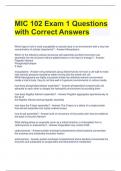
-
MIC 102 Exam 1 Questions with Correct Answers
- Exam (elaborations) • 6 pages • 2024
-
Available in package deal
-
- $9.39
- + learn more
MIC 102 Exam 1 Questions with Correct Answers Which type of cell is most susceptible to osmotic lysis in an environment with a very low concentration of solutes (hypotonic)? - Answer-Mycoplasma Which of the following cellular structures self-assemble (purified monomers can assemble into the structure without added factors or the input of energy)? - AnswerFlagellar filament Phospholipid bilayer S layer mycoplasma - Answer-only prokaryotic group listed that do not have a cell wall to res...
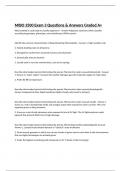
-
MIBO 3500 Exam 3 Questions & Answers Graded A+
- Exam (elaborations) • 15 pages • 2023
- Available in package deal
-
- $12.49
- + learn more
What method is used today to classify organisms? - Answer Polyphasic taxonomy which classifies according to genotype, phenotype, and evolutionary (rRNA) reasons Identify the common characteristics of Deep-Branching Thermophiles - Answer 1. High mutation rate 2. Fastest doubling rates of all bacteria 3. Diverged the earliest from ancestral archaea and eukaryotes 4. Genomically, they are bacteria 5. Usually exist in very hot environments, such as hot springs Describe what makes bacteria ...
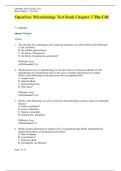
-
OpenStax Microbiology Test Bank Chapter 3 The Cell
- Exam (elaborations) • 18 pages • 2024
-
- $17.49
- + learn more
OpenStax Microbiology Test Bank Chapter 3 The Cell * = Correct answer Multiple Choice 1. The idea that life could appear from nonliving materials was called which of the following? A. the cell theory B. the cellular genesis theory C. the theory of biogenesis D. the theory of spontaneous generation* Difficulty: Easy ASM Standard: N/A 2. The first known use of epidemiology to trace the source of a disease outbreak was the identification of contaminated water as the cause of cholera...
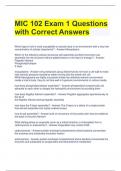
-
MIC 102 Exam 1 Questions with Correct Answers
- Exam (elaborations) • 6 pages • 2023
-
Available in package deal
-
- $8.79
- + learn more
MIC 102 Exam 1 Questions with Correct Answers Which type of cell is most susceptible to osmotic lysis in an environment with a very low concentration of solutes (hypotonic)? - Answer-Mycoplasma Which of the following cellular structures self-assemble (purified monomers can assemble into the structure without added factors or the input of energy)? - AnswerFlagellar filament Phospholipid bilayer S layer mycoplasma - Answer-only prokaryotic group listed that do not have a cell wall to res...
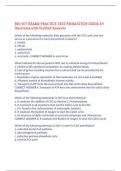
-
BIO 207 EXAM2 PRACTICE TEST FROM STUDY GUIDE 49 Questions with Verified Answers,100% CORRECT
- Exam (elaborations) • 12 pages • 2024
-
- $10.99
- + learn more
BIO 207 EXAM2 PRACTICE TEST FROM STUDY GUIDE 49 Questions with Verified Answers Which of the following molecules links glycolysis with the TCA cycle, and also serves as a precursor for many biosynthetic products? a. malate b. citrate c. oxaloacetate d. acetyl-CoA e. succinate - CORRECT ANSWER d. acetyl-CoA What methods do microorganisms NOT use to minimize energy for biosynthesis? a. Inhibit or kill nutritional competitors by making antimicrobials b. Loss of genes encoding enzymes f...
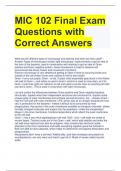
-
MIC 102 Final Exam Questions with Correct Answers
- Exam (elaborations) • 20 pages • 2023
-
Available in package deal
-
- $8.99
- + learn more
MIC 102 Final Exam Questions with Correct Answers What are the different types of microscopy and staining and when are they used? - Answer-Types of microscopy include: light microscopy- used primarily to get an idea of the form of the bacteria, used in combination with staining to get an idea of Gram positive and Gram negative protein. Green fluorescent is used to observe cell occurrences like binary fission and movement of proteins. Electron microscopy is very detailed at getting an i...
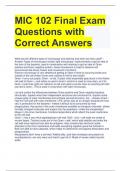
-
MIC 102 Final Exam Questions with Correct Answers
- Exam (elaborations) • 20 pages • 2024
-
Available in package deal
-
- $14.99
- + learn more
MIC 102 Final Exam Questions with Correct Answers What are the different types of microscopy and staining and when are they used? - Answer-Types of microscopy include: light microscopy- used primarily to get an idea of the form of the bacteria, used in combination with staining to get an idea of Gram positive and Gram negative protein. Green fluorescent is used to observe cell occurrences like binary fission and movement of proteins. Electron microscopy is very detailed at getting an i...
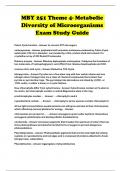
-
MBY 251 Theme 4- Metabolic Diversity of Microorganisms Exam Study Guide
- Exam (elaborations) • 5 pages • 2024
- Available in package deal
-
- $10.99
- + learn more
MBY 251 Theme 4- Metabolic Diversity of Microorganisms Exam Study Guide...
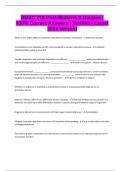
-
BMSC 210 Post-Midterm 2 Quizzes 100% Correct Answers Verified Latest 2024 Version
- Exam (elaborations) • 13 pages • 2024
-
Available in package deal
-
- $8.99
- + learn more
BMSC 210 Post-Midterm 2 Quizzes | 100% Correct Answers | Verified | Latest 2024 Version Which is one major difference between anaerobic and aerobic respiration? - Electron acceptor Fermentation has a relatively low ATP yield compared to aerobic respiration because - oxidative phosphorylation yields a lot of ATP. Aerobic respiration and anaerobic respiration use different ________________, while chemolithotrophs and chemoorganotrophs use different _________________. - electron acceptors / ...
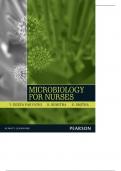
-
Microbiology for Nurses by V. Deepa Parvathi, R. Sumitha, S. Smitha.
- Exam (elaborations) • 445 pages • 2024
-
- $18.49
- + learn more
Microbiology is the study of microscopic organisms and involves the handling, identification, and manipulation of organisms of microscopic size (not visible to the naked eye). These organ- isms possess a simple anatomic structure with differentiation of cells and tissues. The microbial world includes prokaryotic and eukaryotic cells, which fundamentally differ from each other in the organization of the nucleus. In addition, the microbial world includes acellular obligatory parasites—viruses—...

How did he do that? By selling his study resources on Stuvia. Try it yourself! Discover all about earning on Stuvia


